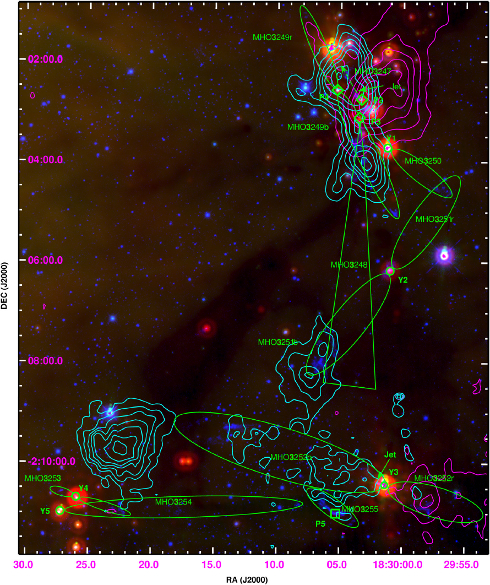Molecular hydrogen jets and outflows in the Serpens south filamentary cloud,
Astronomy and Astrophysics, Volume 543, pp. A51 (2012)
We map the jets and outflows from the Serpens South star-forming region and find an empirical relationship between the magnetic field and outflow orientation. We performed near-infrared H2 ν = 1-0 S(1) 2.122 µm – line imaging of the ~30’ – long filamentary shaped Serpens South star-forming region, and used Ks broadband imaging of the same region for the continuum subtraction. Candidate driving sources of the mapped jets/outflows are identified from the list of known protostars and young stars in this region, which was derived from studies using Spitzer and Herschel telescope observations. We identify 14 molecular hydrogen emission-line objects (MHOs) in our continuum-subtracted images. They are found to constitute ten individual flows. Among these, nine flows are located in the lower-half (southern) part of the Serpens South filament, and one flow is located at the northern tip of the filament. Four flows are driven by well-identified Class 0 protostars, while the remaining six flows are driven by candidate protostars mostly in the Class I stage, based on Spitzer and Herschel observations. The orientation of the outflows is systematically perpendicular to the direction of the near-infrared polarization vector published in the literature. No significant correlation was observed between the orientation of the flows and the axis of the filamentary cloud.

Figure 1 | A color image of the southern region studied. In this image, the Spitzer MIPS 24 µm data is indicated in red, Spitzer MIPS 4.5 µm in green, and H2 narrowband image in blue. The images use a logarithmic scale. The red- and blue-shifted CO emission mapped by Nakamura et al. (2011) is displayed using, respectively, pink and blue contours.
Detailed observations of nearby star-forming molecular clouds are essential to understand the mechanisms of star formation. The Serpens South molecular cloud and its associated proto-cluster, lying at just ~260 pc from Earth, are among the closest such targets, thus, making this cloud one of the best objects for studying the details of star formation.
Thanks to infrared and submillimetre data made available in the last few years, this molecular cloud has already been studied extensively. However, new magnetic field measurements of the entire filament encompassing the Serpens South proto-cluster now allow the evaluation of the relations between the outflows and the local magnetic field. In fact, while some studies have found the outflows to be perpendicular to the cloud axis, others failed to find such relation. Therefore, in order to answer this question, it is imperative to clearly determine the directions of the outflows relative to the cloud axis.
This team now performed deep sub-millimeter observations of the entire Serpens South filament with the 3.5 meter telescope at the German-Hispanic Astronomical Center at Calar Alto, in the H2 ν = 1-0 S(1) 2.122 µm narrow-band. Figure 1 depicts the data obtained, as well as the previously available Spitzer data and the CO emission maps (Nakamura et al. 2011).
This allowed the detection of a total of 10 outflows – 5 bipolar outflows and another 5 unilobular ones – which were then associated with the most likely Class 0 or Class I driving source. These sources and outflows were individually analyzed and, comparing the results with Spitzer infrared maps, were found to be a complete census of the Serpens South filament. Two jet-like structures and a disk seen edge-on were also identified in this region.
In accordance to previous results from other groups, roughly 71% of these outflows were found to be perpendicular to the filament, while about 29% were parallel, although this sample is not large enough to reach statistical significance. However, it was also possible to determine that the near-infrared polarization vectors of 7 driving sources are orthogonal to the outflows and, therefore, also to the sources' magnetic field.
Guilherme Teixeira performed the data reduction, with Jorge Grave, and catalogued the sources, with Nanda Kumar. The observational data was obtained by all authors, who also participated in the data analysis and discussion, with a major contribution from the CAUP members.

